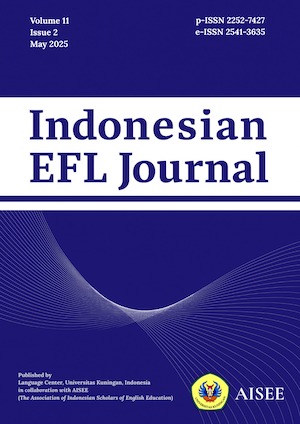NONVERBAL COMMUNICATION PERFORMED BY FOREIGN ENGLISH TEACHER
Abstract
This paper specifically aims at knowing the types of nonverbal communications performed by the foreign English teacher based on Schmitz’s (2012) theory and finding out the students’ responses toward the foreign English teacher’s nonverbal communication. Qualitative research design was applied in this research. The participants of this research were the foreign English teacher and the students of class VII A MTsN 2 Kuningan. The data were collected through observation, interview, and questionnaire. The data were analyzed both qualitative and quantitative. The results of the research revealed that the foreign English teacher performed 3 types of nonverbal communication: 1) kinesics (includes gesture: emblems and illustrators, head movements and posture, eye contact, and facial expression); 2) vocalics; and 3) proxemics. However, the foreign English teacher did not perform adaptors and haptics in the classroom. He confessed that he did not really do certain gestures while feeling nervous, and for the American teacher, haptics (communication by touch) is a sensitive thing, and a difficult area. Regarding the students’ responses, they felt motivated learning English with the foreign English teacher because it made them happy, excited, proud, enthusiastic, and have willingness to learn more. It was showed that 89,6% of the students responded positively toward nonverbal communication performed by the foreign English teacher in teaching learning process, and being responded negatively by 10,4%. Furthermore, it emphasizes that teachers should be aware in applying nonverbal communication to create educative interesting atmosphere for the students and make the teaching learning process effective as well as motivating them.
Keywords: nonverbal communication; foreign teacher; student’s response.References
Bambaeeroo, F., & Shokrpour, N. (2017). The impact of the teachers' non-verbal communication on succes in teaching. Journal of Advances in MEdical Education & Professionalism, 5(2), 51-59.
Creswell, J. W. (2012). Educational research: Planing, conducting, and evaluating quantitative and qualitative research (Fourth Edition). Boston, MA: Pearson Education, Inc.
Devito, J. A. (2002). Human communication. Boston: Pearson.
Fraenkel, J. R., Wallen, N. E., & Hyun, H. H. (2012). How to Design and Evaluate Research in Education. New York: McGraw-Hill.
Haliq, A., & Nasta, M. (2016). The influence of lecturer's nonverbal communication toward students' interest in learning. Jurnal Retorika, 9(2), 90-63.
Herdiansyah, H. (2013). Wawancara, Observasi, dan Focus Groups Sebagai Instrumen Penggalian Data Kualitatif. Jakarta: Rajawali Pers.
Hidayatullah, R. (2019). Cross cultural communication: Different meaning of gesture in several countries. Retrieved from https://doi.org/10.31219/osf.io/m9c5x
Huang, L. (2011). Nonverbal communication in college English classroom. Journal of Language Teaching and Research, 2(4), 903-908.
Indrawan, I. P., Nitiasih, P. K., & Piscayanti, K. S. (2017). An analysis of teachers' non-verbal communication in EFL classroom at SMP Negeri 3 Banjar. PRASI, 12(1), 1-11.
Karim, A. H., & Sotoudehnama, E. (2017). A qualitative study on teacher's nonverbal communication and Iranian EFL learners' perception of language learning. Journal of Language Horizons, 1(1), 109-133.
Kirby, S. (2020). Retrieved from Common Causes of Lack of Motivation and How to Overcome Them: https://www.betterhelp.com/advice/motivation/common-causes-of-lack-of-motivation-and-how-to-overcome-them/
Lamichhane, Y. (2016). Non-verbal skills unavoidable in communication. REPOSITIONING The Journal of Business and Hospitality, 1(1), 91-98.
Mahadi, T., & Jafari, S. M. (2012). Motivation, its types, and its impacts in language learning. International Journal of Business and Social Science, 3(24), 230-235.
McLeod, S. A. (2018). Questionnaire: definition, examples, design and types. Retrieved from Simply Psychology: https:///www.simplypsychology.org/questionnaires.html
Miles, M. B., & Huberman, A. M. (1984). Qualitative Data Analysis. London: Sage.
Nur, S. (2014). Cross Cultural Understanding. Makassar: Alaudin University Press.
Pan, Q. (2014). Nonverbal teacher-student communication in the foreign language classroom. Theory and Practice in Language Study, 4(12), 2627-2632.
Panjaitan, T., Suryani, I., & Chairunisak, S. (2017). Interaction of verbal communication of the teacher from the Philippines in the teaching activity for nursery II students at the Singapore international school, Medan. International Journal of Scientific & Technology Research, 6(7), 33-40.
PeaceCorps. (n.d.). Diambil kembali dari www.peacecorps.gov/educators/global-connections/
Prabavathi, R., & Nagasubramani, P. C. (2018). Effective oral and written communication. Journal of Applied and Advanced Research, 3(1), 29-32.
Rahmat, A. (2018). Teachers' gesture in teaching EFL classroom of Makassar state university. Metathesis: Journal of English Language Literature and Teaching, 2(2), 236-252.
Raymond, H. (2016). The art of nonverbal communication in practice. The Hearing Journal, 69(05), 22-24.
Santoso, A. M., Amin, M., Sumitro, S. B., & Lukiati, B. (2017). Learning motivation of students during the implementation of lecturing based in silico approach. International Journal of Research and Review, 4(9), 6-9.
Schmitz, A. (2012). A premier and communication studies. Retrieved from http://2012.books.lardbuckket.org
Selle, A. (2015). Nonverbal codes in English classroom interaction: Ethnographic study at State Islamic College (Stain) Parepare. Al-Ishlah, 13(1), 75-87.
Sercu, L. (2006). The foreign language and intercultural competence teacher: The acquisition of a new professional identity. Intercultural Education, 17(1), 55-72.
Sugiyono. (2016). Metode Penelitian Kuantitatif, Kualitatif, dan R&D. Bandung: Alfabeta.
Sutiyatno, S. (2018). The effect of teacher's verbal and nonverbal communication on students' English achievement. Journal of Language Teaching and Research, 9(2), 430-437.
Wahyuni, A. (2017). The power of verbal and nonverbal communication in learning. 1st International Conference on Intellectuals' Global Responsibility (ICIGR 2017) (hal. 80-83). Sidoarjo: ATLANTIS PRESS.
Zeki, C. P. (2009). The importance of non-verbal communication in classroom management. Procedia Social and Behavioral Sciences, 1(1), 1443–1449.









